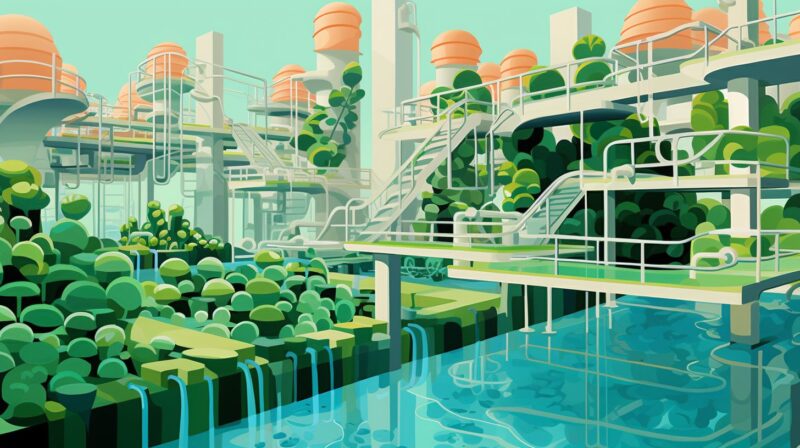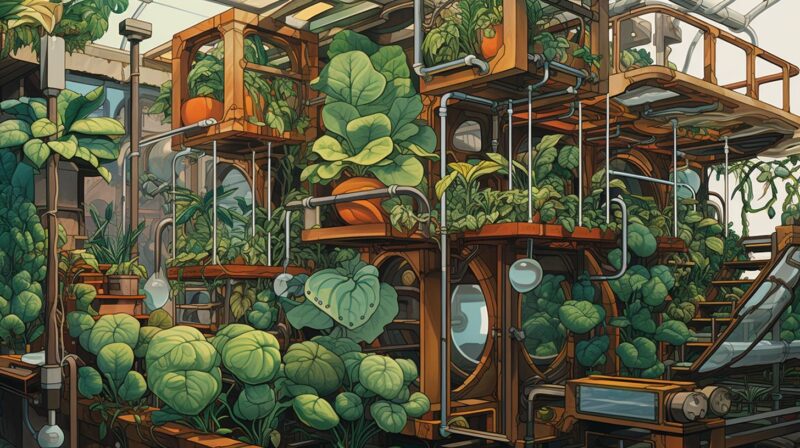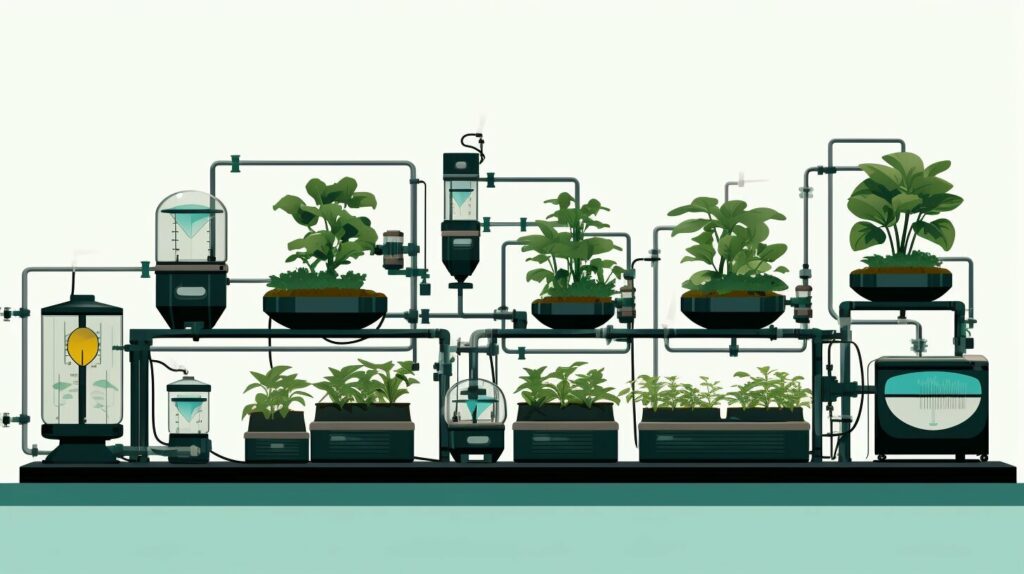This post may contain affiliate links and we may earn a small commission when you click on the links at no additional cost to you. As an Amazon Affiliate, we earn from qualifying purchases. You can read our full disclaimer here.
When it comes to aquaponics, regular maintenance, and monitoring are essential to ensuring a healthy and thriving system. By following this comprehensive checklist, you can maintain optimal conditions for your aquaponics system and keep it running smoothly.
Key Takeaways:
- Regular maintenance and monitoring are essential for a healthy aquaponics system.
- Following a comprehensive checklist can help maintain optimal conditions.
Understanding Aquaponics Systems
Aquaponics may be the perfect fit if you’re interested in sustainable farming or want a new hobby. Combining aquaculture and hydroponics, an aquaponics system allows you to raise fish and grow plants in a closed-loop system. Not only is it sustainable and eco-friendly, but it also has the potential to be a profitable business venture.
An aquaponics system is a closed-loop ecosystem where fish waste becomes plant nutrients and clean water for fish. This means reduced water usage and the potential for organic plant growth without pesticides or fertilizers.
If you’re interested in starting your own aquaponics business, there are a few things to consider. You’ll need to research the requirements for your aquaponic system, the types of fish and plants you’ll want to grow, and the amount of space you’ll need.
Aquaponics is a great way to bring sustainability into your farming practices. Proper planning and consideration make it possible to create a thriving aquaponics system that benefits plants and fish.
Starting Your Own Aquaponics System

If you’re interested in starting your own aquaponics system, there are a few key steps you’ll need to take. First and foremost, understand the concept of a closed-loop system. This means everything within the system is interconnected, from the fish to the plants to the water that circulates between them. Maintaining a closed loop can create a sustainable ecosystem that requires minimal input.
Before you dive in, keep researching! Aquaponics requires careful planning, especially regarding location, system size, and fish and plant selection. You’ll want to consider what type of aquaponics system you want to build – whether it’s a small-scale system for personal use or a more extensive system for a commercial aquaponics business.
Once you’ve researched and identified the type of system you want to build, it’s time to gather the necessary materials. This can include everything from tanks and grow beds to pumps and filters. Some people prefer to purchase aquaponics kits, which come with pre-packaged essentials to make setup easier.
It’s important to remember that maintaining a healthy and thriving aquaponics system requires regular attention and monitoring. When starting out, it’s crucial to establish a routine for checking water quality, assessing the health of your fish and plants, and making necessary adjustments. By following these steps and maintaining a closed-loop system, you can enjoy the benefits of a sustainable and efficient aquaponics setup.
Components of an Aquaponics Setup
If you’re interested in aquaponics, you may be wondering about the components of an aquaponics setup that make it work. Without these essential parts, you can’t create a thriving aquaponics system. Here are the key components you’ll need to get started:
Fish Tank
The fish tank is a vital component of an aquaponics system that provides the nutrients necessary for plant growth. The fish produce waste, which contains ammonia, nitrates, and other nutrients. Plants thrive on these nutrients, breaking down the waste into nitrites and nitrates through nitrification. The plant roots absorb these nutrients, and the purified water returns to the fish tank. That’s the beauty of a closed-loop system!
Grow Bed
The grow bed is where the plants grow in your aquaponics system. The plants sit in a media-filled bed where their roots can absorb the nutrients from the fish tank water. The grow bed is also where the nitrification process happens, converting fish waste into nutrients the plants can use. When the water flows back into the fish tank after passing through the grow bed, it is free of excess nutrients and purified.
Water Pump
The water pump transfers water from the fish tank to the grow bed. A good quality water pump will ensure the water circulates effectively and efficiently throughout the aquaponics system, providing all the plants and fish with the necessary nutrients and oxygen.
Filtration System
Water quality is essential for a healthy aquaponics setup. That’s why you need a filtration system to remove solids, debris, and excess nutrients from the water. A sound filtration system will ensure the water in your aquaponics system stays clean and healthy, reducing the risk of disease or plant failure due to poor water quality.
DIY or Buy?
You can purchase an aquaponics kit with all these components or build your own system. If you’re new to aquaponics, starting with a kit is often best, as it’s typically more manageable and more straightforward to set up. But if you’re handy and enjoy DIY projects, building your own system can be a fun and rewarding challenge.
Choosing Fish and Plants for Your Aquaponics System

When selecting fish and plants for your aquaponics system, there are a few things to consider to ensure a thriving ecosystem. First, you’ll need to think about the type of fish species you want to grow. Some popular options for aquaponics include tilapia, trout, and catfish, but many choices are available.
Fish Species
When choosing a fish species, consider factors such as water temperature, pH levels, and the type of food they require. Some fish species are more tolerant of fluctuating pH levels and temperature changes, making them more suitable for beginners. However, suppose you’re an experienced aquaponics grower. In that case, you may want to raise more challenging fish species requiring specific water conditions.
Plant Selection
Next, consider the plants you want to grow in your aquaponic system. Many beginner aquaponics growers opt for leafy greens like lettuce and spinach, as they are easy to grow and require a lower pH. However, you can also grow herbs, fruits, and vegetables if you maintain the necessary pH level for optimal growth.
PH Level
It’s essential to ensure that the pH level of your system is suitable for both the fish and plants. The ideal pH level for most fish species is between 6.5 and 7.5. However, some species, such as tilapia, require a pH level of around 7.5 to 8.0. On the other hand, most plants require a pH level between 6.0 and 7.0.
Aquaponics Kits
Using an aquaponics kit can be a great way to get started for those new to aquaponics. These kits come with pre-selected fish and plant options and provide all the necessary equipment to set up your aquaponics system. However, if you’re more experienced, you may prefer to select your own fish and plants and set up your system from scratch.
Choosing fish and plants for your aquaponics system is essential to maintaining a balanced ecosystem. By considering fish species, plant selection, and pH levels, you can ensure the success of your aquaponics system.
Maintaining Water Quality in Aquaponics
As you begin to learn the basics of aquaponics, it’s essential to understand how to maintain water quality properly. Water quality is critical for the success of your aquaponics system.
Monitoring Water Temperature
Ensuring the proper water temperature is crucial for fish and plant health. Most aquaponic systems work best at temperatures between 68 and 86 degrees Fahrenheit.
Keeping your system away from direct sunlight and in a well-ventilated area is essential to maintain optimal water temperature. If the water temperature rises too high, you can cool it down by adding ice or using a water chiller.
Managing Fish Waste
Fish waste is a natural byproduct of aquaponics and can quickly accumulate in the system. If not managed correctly, fish waste can become toxic to your fish and plants.
You can use a filter to remove solid waste from the water to manage fish waste. You can also add beneficial bacteria to break down the waste into nutrients your plants can use.
Maintaining the pH Level
The health of your fish and plants depends on the pH balance of your system. Different fish species have different preferred pH levels. Generally, most plants and fish thrive at a pH of 6.5-7.5.
You can maintain the pH level by regularly testing the water and adjusting it with pH up or down solutions.
Regular Testing and Adjustments
Regular testing and adjustments are essential to maintain water quality in your aquaponics system. You should test the water quality at least once a week to ensure that the pH, ammonia, nitrite, and nitrate levels are within a safe range for your fish and plants.
Remember to record your test results and adjustments to track changes in your system over time.
Following these basic guidelines for maintaining water quality ensures your aquaponics system is healthy and thriving. Regular monitoring and maintenance will keep your system running smoothly and ensure your fish plants grow at their best.
Maximizing Plant Growth in Aquaponics

Now that you’ve established your aquaponics system, it’s time to focus on the plants. With proper care and attention, your aquaponics grow bed can yield a rich harvest of fresh, organic produce. Here are some tips for maintaining your aquaponics system and maximizing plant growth:
Provide Adequate Lighting
Plants need sunlight to grow, but indoor aquaponics systems may not receive enough natural light. Consider installing artificial lighting to supplement natural light and provide the necessary amount for optimal plant growth. LED lights are highly energy-efficient and can be easily adjusted to mimic the natural light cycles.
Supplement Nutrients When Necessary
While aquaponics systems generally provide adequate nutrients for plants, there may be times when additional supplementation is necessary. When plants are not growing as quickly or producing as much as they should, it may be a sign of nutrient deficiency. Add organic supplements like fish emulsion or seaweed extract to boost plant growth.
Manage Your Grow Bed
Your grow bed is a critical component of your aquaponics system and requires regular maintenance to keep it functioning correctly. Monitor the water level in the grow bed to ensure proper drainage and prevent waterlogging. Trim excess growth and remove dead or decaying plant matter to avoid clogging the system. Finally, monitor your pH levels regularly to prevent any fluctuations that could negatively impact plant growth.
By correctly maintaining your aquaponics system, you can maintain a healthy and thriving ecosystem that supports the growth of fish and plants. Remember these tips for maximizing plant growth in your aquaponics system and enjoy the bounty of fresh produce it provides.
Troubleshooting Common Aquaponics Issues
Operating an aquaponics system can be a rewarding experience, but it’s not without challenges. To ensure the success of your aquaponics system, it’s essential to be aware of common issues and how to troubleshoot them.
Nutrient Deficiencies
One common issue in aquaponics is nutrient deficiencies in plants. This can occur when the system is not balanced correctly, or water quality is not optimal. Monitor water parameters regularly and adjust nutrient levels accordingly to address this issue. You can also add supplements to the system to provide extra nutrients for the plants.
Disease Outbreaks
Another potential issue in aquaponics is disease outbreaks in fish or plants. Low water quality, overcrowding, or contamination can lead to this issue. To prevent disease outbreaks, it’s crucial to maintain optimal water quality and keep an eye on the health of your fish and plants. If an outbreak does occur, promptly isolate and treat affected individuals.
System Malfunctions
System malfunctions can also occur in aquaponics, such as pump failure or leaks in the system. These issues can disrupt the ecosystem’s balance and compromise your aquaponics system’s success. To avoid system malfunctions, perform regular maintenance and inspections on all equipment. Make repairs or replacements as necessary to keep your system thriving.
Stay vigilant and troubleshoot issues promptly, and you can ensure the long-term success of your aquaponics system.
Checklist for Comprehensive Aquaponics System Checks
If you want to keep your aquaponics system thriving, creating a comprehensive maintenance checklist is essential. Maintaining your system ensures your fish and plants are healthy and your investment is protected.
| No. | Checklist Items | Status |
|---|---|---|
| 1 | Understand the closed-loop concept of aquaponics | |
| 2 | Research system requirements and types | |
| 3 | Determine location and system size | |
| 4 | Choose fish and plant species | |
| 5 | Gather necessary materials (tanks, grow beds, etc.) | |
| 6 | Set up aquaponics system or kit | |
| 7 | Establish routine for water quality checks | |
| 8 | Monitor fish and plant health regularly | |
| 9 | Maintain proper water temperature | |
| 10 | Manage fish waste and use beneficial bacteria | |
| 11 | Monitor and adjust pH levels | |
| 12 | Test water quality (pH, ammonia, nitrite, nitrate) | |
| 13 | Provide adequate lighting for plants | |
| 14 | Supplement nutrients as needed | |
| 15 | Monitor and maintain grow bed drainage | |
| 16 | Regularly trim and maintain plants | |
| 17 | Record test results and system adjustments | |
| 18 | Maximize plant growth with artificial lighting |
Conclusion
Congratulations on completing this comprehensive guide to aquaponics systems. By following the checklist for comprehensive aquaponics system checks, you’re well on your way to maintaining a healthy and thriving system.
Starting your own aquaponics system can be an exciting and rewarding journey. Whether you’re interested in pursuing an aquaponics system business, raising fish, or growing your own organic vegetables, aquaponics offers numerous benefits.
Remember to conduct regular maintenance and monitoring, as well as troubleshooting any issues promptly, to ensure the success of your aquaponics system. You can create a sustainable and efficient agricultural system by maintaining a healthy ecosystem and optimizing plant growth.
Thank you for reading! We wish you the best in your aquaponics journey.



